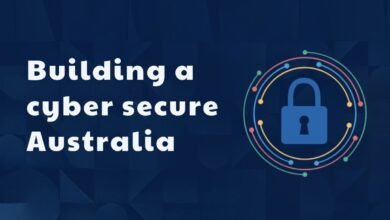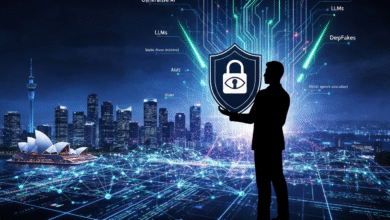Post-Quantum Security: Why You Need It Now

▼ Summary
– Australia faces a technological shift as quantum computing threatens current cryptographic systems that protect government, business, and personal data.
– Quantum computers use qubits to process information exponentially faster, enabling them to crack widely used encryption algorithms like RSA and ECC in hours.
– The Australian Government has prioritized post-quantum cryptography in its cyber security strategy, emphasizing the need to secure long-term sensitive data such as medical records and infrastructure blueprints.
– Post-quantum cryptography uses mathematical algorithms resistant to quantum attacks, differing from quantum cryptography and offering strategic advantages against “harvest now, decrypt later” threats.
– Organizations should adopt crypto-agility by piloting PQC, partnering with experts, and aligning with digital transformation to build resilience and avoid risks from delaying or rushing implementation.
Australia currently faces a pivotal technological moment, one that will reshape its approach to cybersecurity. The emergence of quantum computing brings both unprecedented opportunities and a fundamental risk to the cryptographic systems safeguarding sensitive government, corporate, and personal information. While this advanced technology promises breakthroughs in fields like medicine and artificial intelligence, it simultaneously threatens to dismantle the encryption protocols that form the backbone of modern digital security.
Quantum computers operate on principles of quantum mechanics, processing information through quantum bits or qubits. Unlike traditional binary bits that are strictly zeros or ones, qubits can exist in multiple states simultaneously. This unique property allows quantum machines to perform calculations at an exponentially faster rate, solving problems currently beyond the reach of even the most powerful classical supercomputers.
A primary security concern is the ability of these future machines to break widely adopted public-key encryption standards. Algorithms like RSA and Elliptic Curve Cryptography (ECC), which protect everything from online banking to confidential communications, could be rendered obsolete. Data encrypted today using these methods might be decrypted in mere hours by a sufficiently advanced quantum computer, rather than remaining secure for decades.
Acknowledging this looming threat, the Australian Government has identified post-quantum cryptography as a critical national priority in its 2023–2030 Cyber Security Strategy. The strategy urges a fundamental shift in how organizations classify data, moving beyond just sensitivity to also consider longevity. The essential question becomes: for how many years must this information remain confidential?
Data requiring long-term protection, spanning 10 to 30 years, faces the greatest risk. This category includes sensitive medical histories, proprietary engineering designs, and critical national infrastructure plans. The potential fallout from such a security breach is immense, threatening intellectual property, personal privacy, authentication systems, and secure communications. The resulting financial, operational, and reputational damage could be catastrophic without proactive intervention.
Why Post-Quantum Cryptography is Essential
Current cryptographic systems depend on complex mathematical problems that are exceptionally difficult for classical computers to solve. RSA encryption, for instance, relies on the challenge of factoring very large numbers. Quantum computers, however, can leverage algorithms like Shor’s algorithm to solve these problems efficiently, nullifying the security of existing protocols.
It is crucial to distinguish post-quantum cryptography from quantum cryptography or quantum key distribution. PQC involves developing new mathematical algorithms that can run on today’s conventional hardware but are designed to withstand attacks from both classical and quantum computers. This is different from systems that use quantum mechanical phenomena to transmit keys.
A common and dangerous misconception is that current encryption will remain secure indefinitely or that the quantum threat is too far off to warrant immediate action. This complacency creates significant vulnerabilities. Adopting post-quantum cryptography provides a vital strategic advantage, ensuring long-term data confidentiality and defending against “harvest now, decrypt later” attacks, where adversaries collect encrypted data today to decrypt it once quantum technology is available.
Early implementation also helps organizations stay ahead of emerging regulatory requirements, simplifies future cryptographic upgrades, and builds stronger trust with customers and partners. These collective benefits enhance overall business continuity and risk management in a rapidly evolving digital landscape.
Achieving Cryptographic Agility
Transitioning an entire organization’s cryptography is a complex undertaking, not a simple switch. For large enterprises with intricate, interconnected IT systems, the process is comparable to rewiring a skyscraper while it remains fully occupied. This transition requires careful planning and can take many years to complete fully.
A critical error leaders make is either underestimating the urgency or rushing into a full-scale overhaul. A more prudent approach focuses on building agility. The key question is not merely which specific algorithm to adopt, but how to create an infrastructure flexible enough to adapt as standards mature. This begins with a thorough audit to identify which data requires decades of security, which systems are mission-critical, and where operational flexibility is most important.
Running pilot programs and proofs of concept is an effective method to move from theory to practice. Testing new cryptographic solutions in controlled environments, such as within supply chain management systems, helps uncover unforeseen challenges, builds internal expertise, and provides a clearer picture of the return on investment.
No single organization can navigate this transition alone. Collaboration with technology startups, academic institutions, and industry groups fosters shared learning. Furthermore, cloud platforms from providers like IBM, Microsoft, AWS, and Google offer accessible environments for experimentation without the substantial capital investment in dedicated hardware.
Staying informed about evolving international standards, export controls, and government initiatives is equally vital. Proactive compliance and participation in standard-setting processes can transform a regulatory requirement into a tangible competitive edge.
Ultimately, post-quantum cryptography should not be treated as an isolated project. By integrating quantum readiness with broader digital transformation efforts in AI, data analytics, and high-performance computing, organizations can position these initiatives not as costly experiments, but as complementary tools that collectively strengthen their overall resilience.
For Australian businesses and institutions, increasing regulatory, operational, and geopolitical pressures are already elevating cyber resilience to a top strategic priority. Post-quantum cryptography must become an integral part of this discussion. When quantum computing becomes a practical reality, resilience will belong to those who prepared thoughtfully and in advance. The security of future data depends on the actions taken today.
(Source: ITWire Australia)

